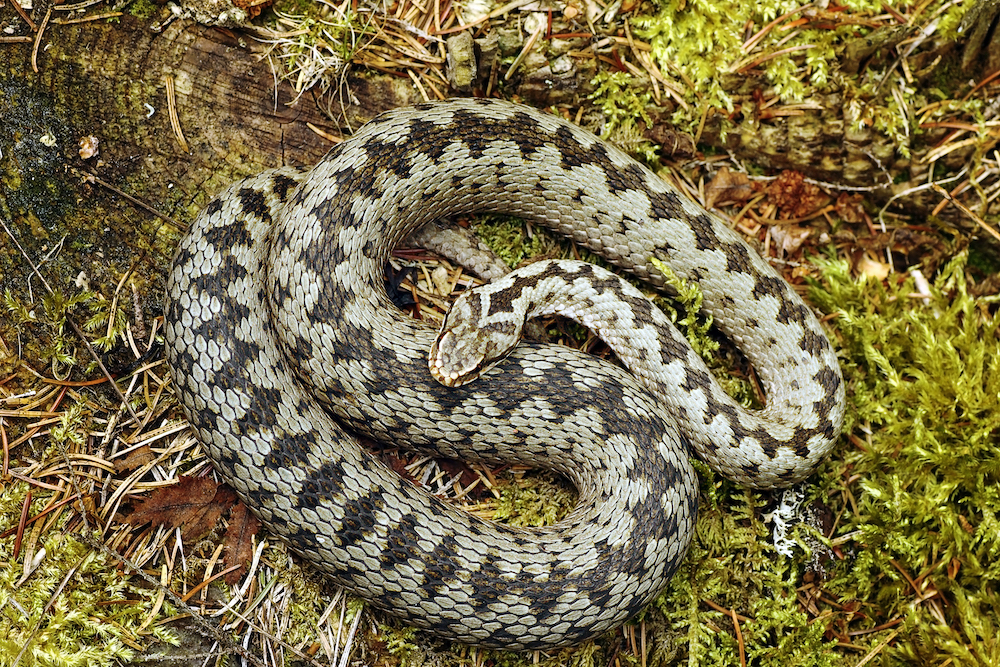
When we think of venomous snakes we tend to think of them being present in other countries but not here in the UK. In fact, the European Adder is the only venomous snake native to the UK.
Fully grown adults adders are roughly 50-60cm long and have a black/brown zigzag pattern along their back and V or X shaped marking on the back of the head as can be seen in the above image.
Whilst adder bites are quite rare they do occur so we wanted to give you some more detailed information about where they live, how to spot an adder bite and what to do if it happens to your dog.
The first thing to mention is that Adders are protected by the Wildlife and Countryside Act 1981, and this means that it is an offence to kill, harm, injure, sell or trade them.
It’s also important to point out that snakes normally only bite in self-defence! A dog would only usually get bitten if they had disturbed or trodden on an adder and in some cases if you get an overly enthusiastic or curious dog getting a bit too up close and personal.
Adder season can usually be classed as any time between April and September and most commonly in the afternoon when the adders are most active and out basking in the sunshine.
Where do Adders live?
Most commonly found in the south and south-west of England, western Wales and Scotland.
Their ideal habitats are sand dunes, rocky hillsides, moorland and woodland edges.
What are the signs of an Adder bite?
The first sign of an adder bite would usually be a yelp from your dog. Following on from that some of the telltale signs to watch out for are listed below:
- Major swelling and in most cases two small puncture wounds in the middle of the swelling
- Limping, whining or signs of discomfort or irritation from your dog
- Irritated or inflamed skin where the venom starts to spread
- Excessive panting, drooling and/or rapid heartbeat
- Vomiting
- Pale gums
- Signs of weakness or lethargy
As we always say when we speak to our experts they always tell us it’s all about knowing what is normal behaviour for your dog and if you spot any signs of anything out of the ordinary it’s always worth taking a closer look for any of the other signs above.
What should you do if your dog gets bitten?
Your number one job is to stay calm swiftly followed by getting your dog to a vet as soon as possible. The more you panic the more your dog will panic and when they panic their heart rate will increase and this will spread the venom faster.
According to Vets4Pets 96-97% of dogs survive adder bites when they receive the appropriate treatment.
If you are still out on your walk when you notice the bite, if possible try and carry your dog back home or to the car as again this will reduce the speed at which the venom spreads.
Another top tip is to bathe the wound in cold water to help control the swelling and try to keep your dog quiet and warm as you travel to your nearest vet practice.
It is a good idea to ring your vet in advance to let them know what has happened and your estimated time of arrival as this will allow them to make any necessary preparations and be ready to act when you arrive.
What's the treatment?
Treatments depend on individual cases but according to Vets4Pets:
“Anti-venom can be used in all cases but is especially recommended for potentially serious cases. Unfortunately, it can be difficult to obtain. It needs to be imported because there is currently no preparation licensed in the UK.”
“Bathe the wound in cold water to help control the swelling and try to keep your dog quiet and warm as you travel to your nearest vet practice.”
Their guidance on treatment is:
“Because the bite and swelling is painful, pain relief will usually be given. Your vet may recommend fluid therapy (a drip) to maintain blood pressure, treat shock and maintain the blood flow of the vital organs. Anti-histamines might be added to the treatment. Sometimes cage rest is recommended to minimize venom absorption into the rest of your dog’s body.”
